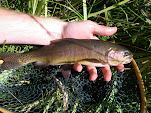Between my outings on the mountain streams around Washington, I have also been getting out on the Puget Sound a fair bit trying to chase down some Coho Salmon. This past week the Coho finally started to really push into the Sound and with the early morning marine layer a good number of salmon have been up around the surface slashing on bait. However, seeing fish and catching fish are two very different things. Coho are notorious for making anglers wish that they could coax a few more feet out of their casting, no matter how far the angler is casting. As such, while I was throwing a good 75 to 85 feet of line, in their typical fashion most of the Coho were feeding 100 to 120 feet off shore. Factoring this in after a couple early mornings on the water, three hook ups and zero Coho landed was all that I had to show for my time. So what do I do when the Coho bite is off, especially once that marine layer burns off? Hunt down some sea-run Cutthroat of course!
Sea-runs are kind of the odd ball of the anadromous world. First they are homebodies, instead of travelling thousands of miles out to sea like Steelhead or salmon, Cutthroat are quite content to remain within 5 or 6 miles of their home stream. Cutthroat in the salt water tend to seek out places that remind them of a river, highly diverse structure and a walking pace current and you are typically looking at good cutthroat habitat. They are also rather near shore oriented, generally cruising in two foot to twelve foot deep water. All of these factors make them a perfect target for fly anglers.
 |
| Fishing some ideal sea-run Cutthroat habitat |
So the other morning with an all too rare blue bird morning in on the Sound and with the salmon off the bite, me and a couple of friends decided to go try and hunt down some of these elusive Cutthroat. Cutthroat fishing on the Sound is always a bit of a cat and mouse game and there wasn't any sign of a Cutthroat at the first spot that we tried. However, we continued to search and at the next spot that we went to, we finally found them. I was fishing an attractor pattern called that Sea-run Bugger, that really doesn't look like anything that a right minded Cutthroat would want to eat, but yet just about every Cutthroat seems hell bent on trying to destroy. Within a handful of casts a beefy 17" Cutthroat came across it and tried to do just that. As soon as I set the hook on this fish it was out of the water and in short unison jumped three more times. I thought that I finally had him on the ropes after the last jump, but right as I went to bring him to the net the hook popped out, saving me the trouble of taking it out myself.
On my very next cast I only had a chance to make a couple of strips before another Cutthroat pummeled my fly. I apparently had a better hookset on this one and after quick but spirited fight I brought the beautiful 15" Cutthroat to hand.
 |
| Beautiful native sea-run Cutthroat in prime condition |
 |
| Another look at the fish... |
While we didn't find fish on every cast after that, fishing did stay good for the next hour or so, with each of us picking up a could of smaller Cutthroat in 10 to 13" range. Then as is typical, the optimum tide window closed and the fish vanished signaling that it was time to call it a day.












4 comments:
Nice fish, I never even know there was a sea run cutt throat. Do you have any pics of that fly you were using?
The sea-run cutthroat is just the anadromous form of the coastal cutthroat subspecies, very cool fish. Pound for pound probably the hardest fighting salmonid and definitely the strongest cutthroat. Here is the fly
http://www.nativetroutflyfishing.com/searunbugger.htm
Excellent report and post. I look forward to looking through your blog.
The Average Joe Fisherman
http://averagejoefisherman.blogspot.com/
http://hubbycoach.blogspot.com/
Man...
Those sure are beautiful cutthroats! I love native/wild fish like that!
Post a Comment